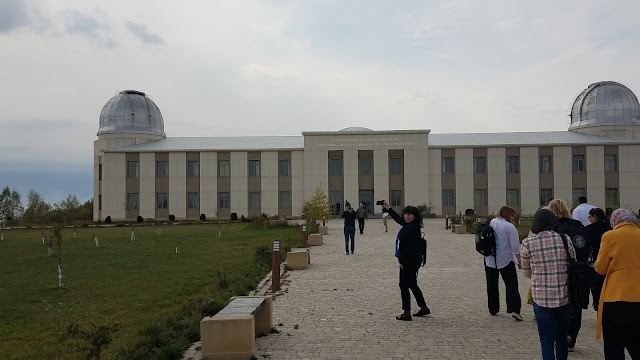Today is the excursion day. It was to visit two space science facility located outside Baku. This actually gave me to see the countryside of Azerbaijan, a country with a population of ~10M people of which about half of the population live in Baku. On our way to the facilities, we witnessed a lot of land fragile. I was wondering why such huge lands are left uncultivated. Later, I found out that until recently the land belongs to the government. Now the government put the land on the market but remain unfordable to many of the local people to purchase the land. The government seems no interest to cultivate the land as the country has other wealth to handle, oil.
 Here is the sign of Russian influence!
Here is the sign of Russian influence!
Here just part of huge land fragile!
The first stop was the Baku-Shamakhy control station, the main Satellite Ground Control Station of Azercosmos. It is located in the territory of Absheron peninsula, near the city of Baku. It is here the three Azerbaijan’s satellites are tracked and controlled. The first Azerspace-1 telecommunication satellite, which was fully built by the U.S. Orbital Sciences Corporation, was launched into geostationary orbit on February 8, 2013 by Arianespace of France with launch vehicle Ariane-5ECA from Guiana Space Centre in Kourou. The second telecommunications satellite (Azerspace-2), also known as Intelsat 38, is built by U.S.-based Space Systems Loral, was launched into geostationary orbit on 25 September 2018, from the Kourou Space center in France Guiana. The third satellite Azerbaijan has is an Earth observation LEO satellite (Azersky). I’m very impressed and even jealous with the performance of Azerbaijan, and managed to successfully launched and operate three satellites within less than 5 years from the start of its space program.



Some of the facilities found in the premises of Azercosmo compound!
The next stop was at the Shamakhi Astrophysical Observatory, which is located in Sharkhi, Azerbaijan, on the south-eastern foothills of the Great Caucasus Mountain ridge about 144 km far from Baku and at an altitude of 1,435 m. The observatory was built during the Russian empire in 1964.
The Juma Mosque of Shamakhy seen from outside!
Some of the internal views inside Juma Mosque of Shamakhy
On our way to the observatory we did stop by and visited the Juma Mosque of Shamakhy. It was first constructed in 743 but seriously damaged due to natural cause (the aftermath the 1859 and 1902 Earthquakes) and foreign invasion (the Armenian invasion who set the mosque on fire in 1918). Finally, with the decree of President Ilam Aliyev, the mosque has been extensively restored and rebuilt during 2010-2013. Although I never been inside any mosque before, I found the internal part of this Mosque is so elegantly decorated. One funny thing that I experienced was that the local mosque guard (may be a kind of guid because he dis not have any weapon to be a guard) asked my local host, who was next to me, where I’m from; and when I said Ethiopia he immediately said ‘Bilal Habesh’. I heard a lot about Bilal but was not sure he is actually so famous around the muslim world. Felt so proud, of course.
In general, it was a busy but so enjoying day. We got back to our hotel late in the evening.
From the Juma Mosque of Shamakhy all the way to the observatory we were escorted by police!
Inside the dome where the telescope is mounted!
At the top of the dome!




























